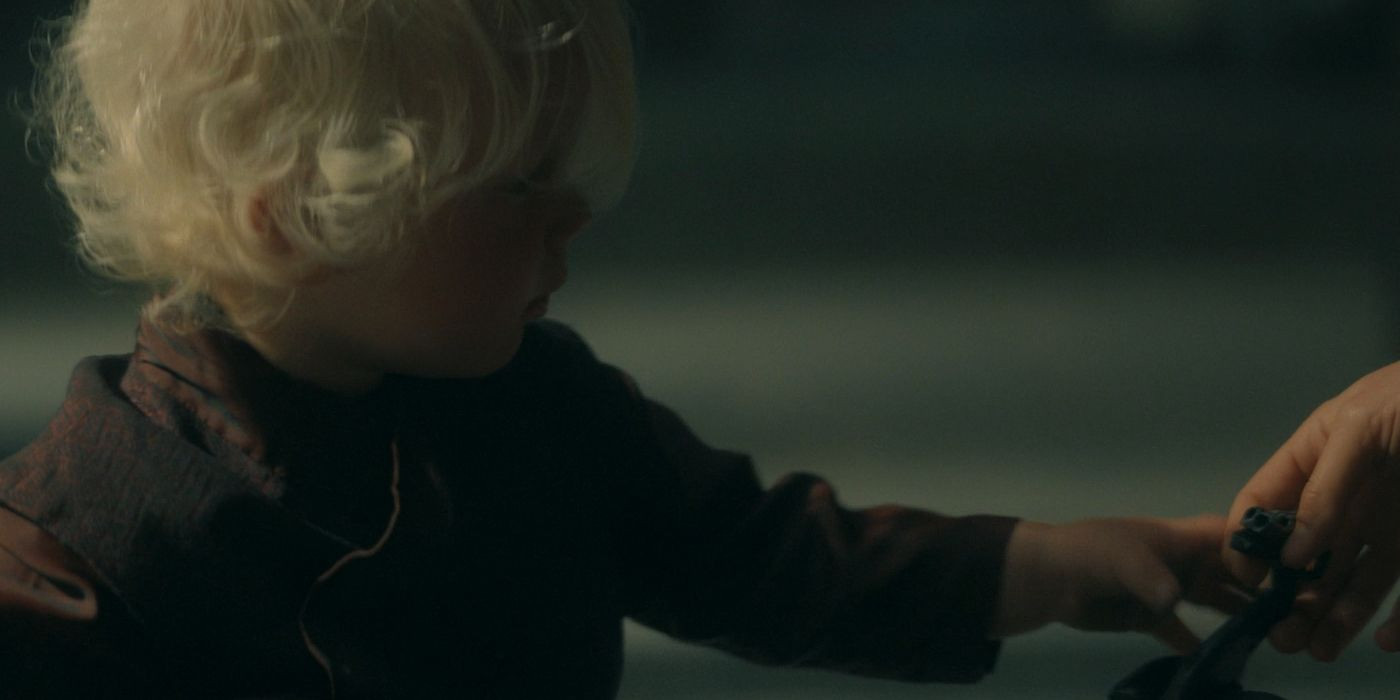The Targaryen Civil War, famously known as the Dance of the Dragons, stands as a brutal and transformative period in Westerosi history. HBO’s House of the Dragon brings this conflict to life, adapted from George R.R. Martin’s Fire & Blood, a historical account of House Targaryen. As viewers delve into the escalating tensions and fiery battles, a central question emerges: Who Wins The Dance Of The Dragons? The answer, much like the war itself, is far from straightforward, marked by devastating losses and a bittersweet conclusion.
Greens vs. Blacks: Understanding the Targaryen Civil War Factions
The Dance of the Dragons erupted from a succession dispute following the reign of King Viserys I Targaryen. Two factions solidified, each backing a different claimant to the Iron Throne. These became known as the Greens and the Blacks.
The Greens rallied behind Aegon II Targaryen, Viserys’ eldest son from his marriage to Alicent Hightower. Queen Alicent and her father, Otto Hightower, the Hand of the King, were instrumental in championing Aegon’s claim. Their faction largely represented the established patriarchal norms of Westeros, favoring male primogeniture and viewing Rhaenyra’s claim as a challenge to tradition. Alicent’s motivations were complex, driven by ambition for her children and a growing conviction that Rhaenyra’s sons were illegitimate, further complicating the succession.
On the other side, the Blacks supported Princess Rhaenyra Targaryen, Viserys’ named heir and eldest child from his first marriage. Her claim was fiercely upheld by her uncle and husband, the charismatic and formidable Daemon Targaryen, and Lord Corlys Velaryon, the Sea Snake, head of House Velaryon. The Blacks argued for Viserys’ explicit designation of Rhaenyra as heir, challenging the precedent of male succession and emphasizing Rhaenyra’s lineage.
| Aegon II’s Biggest Supporters & Lineage In House Of The Dragon | Rhaenyra’s Biggest Supporters & Lineage In House of the Dragon |
|---|---|
| Alicent Hightower | Daemon Targaryen |
| Otto Hightower | Corlys Velaryon |
| Aemond Targaryen | Rhaenys Targaryen |
| Helaena Targaryen | Jacaeyrs Velaryon |
| Daeron Targaryen | Lucerys Velaryon |
| Ser Criston Cole | Joffrey Velaryon |
| Jaehaerys Targaryen | Aegon Targaryen |
| Jaehaera Targaryen | Viserys Targaryen |
While the Greens held the initial advantage of controlling King’s Landing and the Royal Treasury, the Blacks possessed Dragonstone, a strategic stronghold, and crucially, a larger number of dragons and experienced dragonriders at the outset of the war. This balance of power set the stage for a devastating and protracted conflict.
The Dance of Dragons: A Pyrrhic Victory and Devastating Losses
The Dance of the Dragons was characterized by brutal battles, political betrayals, and immense loss on both sides. Dragon battles filled the skies, resulting in unprecedented casualties among the Targaryen dragons, weakening their house for generations to come. Key figures on both sides perished in the conflict.
Despite early successes for Rhaenyra, including capturing King’s Landing and briefly sitting on the Iron Throne, her reign in the capital was tumultuous and short-lived. King’s Landing descended into chaos, and Rhaenyra faced mounting challenges to her rule. Meanwhile, Aegon II, though wounded, continued to wage war, eventually retaking Dragonstone.
The war reached a grim climax when Aegon II captured Rhaenyra in Dragonstone. In a brutal and decisive act, Aegon II effectively “won” a major victory by having his dragon, Sunfyre, burn and devour Rhaenyra. This removed his primary rival and dealt a significant blow to the Black faction.
However, Aegon II’s victory was far from complete and came at a tremendous cost. He was severely injured and weakened by the war, and Rhaenyra’s supporters in the North, led by Lord Cregan Stark, were advancing. His reign, like Rhaenyra’s brief time on the Iron Throne, was marred by instability and devastation.
| Main Characters Who Survive The Dance Of The Dragons | Title/Role |
|---|---|
| Lord Corlys Velaryon | Head of House Velaryon, one of Aegon III’s regents. |
| Aegon III | Aegon II’s successor as king. |
| Viserys II | Succeeds Aegon III’s sons as king. |
| Lord Cregan Stark | Head of House Stark, Hand of the King. |
| Baela Targaryen | Marries Alyn Velaryon and eventually returns to Driftmark. |
| Rhaena Targaryen | Lived in Dragonstone, lost a husband, and then married Garmund Hightower. |
Ultimately, Aegon II’s reign was cut short by poison, orchestrated by his own advisors who recognized the futility of continued conflict and the need for peace. This paved the way for a compromise and an end to the Dance of the Dragons.
Aegon III: A King Forged in Fire and Blood – A Victory for House Targaryen?
Following Aegon II’s death, the Iron Throne passed to Aegon III, Rhaenyra’s eldest surviving son with Daemon Targaryen. At just ten years old, Aegon III ascended the throne, inheriting a kingdom ravaged by war and deeply scarred by loss. He was crowned by Corlys Velaryon, symbolizing a fragile unity after years of brutal division.
While Aegon III’s ascension could be seen as a victory for the Black faction and Rhaenyra’s claim, it was a victory born from immense tragedy. Aegon III himself was traumatized by the war, witnessing his mother’s horrific death. His reign was known for its somber tone, earning him monikers like “the Broken King” and “Aegon the Unlucky.”
Despite the personal cost, Rhaenyra’s bloodline prevailed. All of Alicent Hightower’s children and grandchildren, save for Aegon II’s daughter Jaehaera, perished in the Dance. While Aegon III was briefly married to Jaehaera in an attempt to unite the factions, her death without issue extinguished Alicent’s line. The Targaryen dynasty continued through Aegon III and his brother Viserys II, ensuring the survival of Rhaenyra’s legacy.
 Aegon the Young in House of the Dragon
Aegon the Young in House of the Dragon
The Dance of the Dragons’ Lasting Scars
The Dance of the Dragons left profound and lasting scars on House Targaryen and Westeros. The most visible consequence was the decimation of the Targaryen dragon population. Only four dragons survived the war, a catastrophic loss that significantly diminished Targaryen power and influence in the long run. This dragon decline is a crucial factor in understanding why the Targaryens were less formidable centuries later during Robert Baratheon’s rebellion.
Furthermore, the war inflicted deep emotional wounds. Both Rhaenyra and Alicent suffered tragic fates, consumed by grief and loss. Alicent spent her final years in confinement, while Rhaenyra’s ambition ended in betrayal and death. The Dance served as a stark reminder of the destructive nature of civil war and the heavy price of ambition and power.
House of the Dragon and Divergences from Fire & Blood
House of the Dragon offers a compelling dramatization of the Dance of the Dragons, but it’s important to note that the show makes certain changes from George R.R. Martin’s Fire & Blood. The book presents the Dance through the lens of unreliable historical accounts, leaving room for interpretation. House of the Dragon takes creative liberties, particularly in fleshing out the relationship between Alicent and Rhaenyra, portraying their conflict as a more personal tragedy rooted in lost friendship.
Other notable differences include:
- Emphasis on Alicent and Rhaenyra’s relationship: The show highlights their bond and subsequent fallout more intensely than the book.
- Laenor Velaryon’s fate: In House of the Dragon, Laenor survives, faking his death, while in Fire & Blood, he dies earlier.
- Lucerys Velaryon’s death: The show frames it more as an accident, while the book leaves it more ambiguous.
- Aegon’s “Song of Ice and Fire” dream: Added in the show as a key motivator for Alicent’s actions.
These changes enhance the dramatic narrative for television, but the core outcome of the Dance of the Dragons and the question of “who wins” remains consistent with the source material.
Conclusion: A War Without True Victors
In conclusion, there is no definitive “winner” of the Dance of the Dragons. While Aegon II claimed a tactical victory by killing Rhaenyra, his triumph was short-lived and pyrrhic. His death soon after and the ascension of Rhaenyra’s son, Aegon III, to the Iron Throne can be interpreted as a long-term victory for the Black faction.
However, the Dance of the Dragons is ultimately a tragedy. Both factions endured devastating losses, countless lives were lost, and the Targaryen dynasty was irrevocably weakened. The war’s legacy is one of destruction and sorrow, a stark reminder of the futility of internal conflict. While Rhaenyra’s line continued to rule, the Dance of the Dragons serves as a cautionary tale of ambition, succession, and the devastating consequences of civil war, leaving a complex and bittersweet answer to the question of who truly wins.
[

